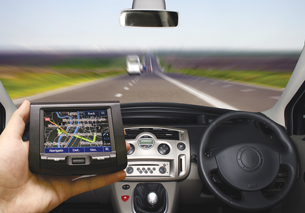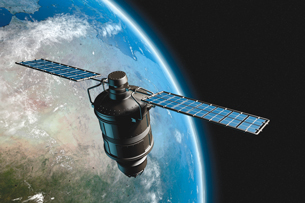Module 5—Circular Motion
In This Module
Lesson 1—Understanding Circular Motion
A simulation will help you visualize circular motion and examine the application of Newton’s first and second laws to circular motion. What is the role of centripetal force in circular motion? What is the relationship between centripetal force and radius, mass, and velocity?
As you work through this lesson, you will explore the following questions:
- How do Newton’s first and second laws apply to circular motion?
- What factors affect acceleration during circular motion?
Lesson 2—Newton’s Laws Applied to Vertical Circular Motion
This lesson will continue to apply the principles of Newton’s first and second laws to vertical circular motion. You will use a simulation that utilizes free-body analysis and Newton’s second law to help you understand the acceleration acting on an object that moves along a vertical circular path. What is the difference between the acceleration of an object at the top of its vertical circular path and the acceleration at the bottom of its vertical circular path?
You will explore the following essential questions:
- How do Newton’s laws explain the sensations during vertical circular motion, such as in a loop on a roller coaster?
- What forces come into play during vertical circular motion?
Lesson 3—Kepler’s Three Laws of Planetary Motion
An examination of the three laws of planetary motion that were formulated by Kepler in the early 1600s forms the basis of this lesson. The focus of these laws is to explain the nature of planetary motion, not to explain why this motion occurs. A simulation, which uses astronomical units, will be used to explore Kepler’s three laws and how they accurately describe planetary motion. Exactly how did people come to understand the motion of our solar system in the 1600s?
You will explore the following essential question:
- How did Kepler’s laws help calculate the position of the planets as they orbited the Sun?
Lesson 4—Planetary and Satellite Motion
In this lesson you will extend your understanding of planetary motion and look at why planetary motion occurs. What is the relationship between Newton’s universal law of gravitation and the orbit of any satellite or moon? How do you explain planetary motion and satellite motion using universal gravitation and the principles of circular motion?
You will explore the following essential question:
- How are planetary and satellite motion explained using universal gravitation and the principles of circular motion?
Module 5 Assessment
The assessment for Module 5 consists of four (4) assignments, as well as a final module inquiry project.
- Module 5: Lesson 1 Assignment
- Module 5: Lesson 2 Assignment
- Module 5: Lesson 3 Assignment
- Module 5: Lesson 4 Assignment
- Module 5 Project
Module 5 Project: Global Positioning Satellites
Getting Started

© Olaru Radian-Alexandru /shutterstock
This module project is based on an understanding of global positioning systems (GPS) and how they relate to circular motion, gravitational fields, and the past and future impacts of technology on society.
Global positioning systems are proliferating in our society in many ways. Cell phones, cars, pet tags, and other applications are evolving to incorporate this technology.
Applications, such as "arrive alive," will allow cell-phone position, movements, and whereabouts to be tracked in real time. Imagine parents monitoring where their children are at all times, being notified if the phone travels outside a "boundary" or if the motion of the phone is in a vehicle that exceeds the local speed limit. These are issues that are being discussed now, and they are all related to satellite technology that is based on circular motion and gravitational fields. In fact, if you have a cell phone, you are already carrying this technology.
Project Tasks
This inquiry project involves four major questions with two related tasks in each.
- How is GPS technology used to solve problems?
- Investigate where GPS applications are being used, noting societal issues that have "popped-up" as a result of their applications.
- Create a list of applications or problems that GPS technology could be used to solve.
- Investigate where GPS applications are being used, noting societal issues that have "popped-up" as a result of their applications.
- How does GPS work?
- Research the network of satellites that are used to power the current world GPS system, and describe how this technology functions.
- Report on the orbital specifications of the GPS satellites. For example, report about the mass, altitude, and orbital period of GPS satellites.
- Research the network of satellites that are used to power the current world GPS system, and describe how this technology functions.
- Describe how principles of circular motion determine the orbital path of a satellite.
- Given a satellite's mass and orbital altitude, how is the speed of the satellite determined?
- How is a satellite's speed and altitude related to the launch vehicle requirements?
- Given a satellite's mass and orbital altitude, how is the speed of the satellite determined?
- How does Earth's gravitational field cause the orbital path of the satellite?
- Determine the acceleration due to gravity at the GPS satellite's orbital altitude using Newton's universal law of gravitation.
- Relate the orbital acceleration to the velocity as a verification using
 .
.
- Determine the acceleration due to gravity at the GPS satellite's orbital altitude using Newton's universal law of gravitation.
Submitting Your Project

© Cristi Matei/shutterstock
Your project must be submitted as a computer presentation using the software of your choice (e.g., PowerPoint, Word, HTML, PDF).
Your presentation will include a simulation of the GPS orbital path that verifies your calculations. You may use the Weight and Orbits simulation used in Lesson 4, or you may create this simulation using other technologies.
Your presentation will include answers to the four major questions posed under Project Tasks.
Your presentation should conclude by explaining how orbital knowledge supports the infrastructure for new technologies and their application in solving both old and new problems.
Be sure to include a reference page listing all of your research sources for this project. List all web pages, books, and magazine articles you use.
Research
Begin your research by searching the Internet for the phrase “Global Positioning System GPS.”
You might also want to search for a tutorial on GPS.
How Will Your Project be Assessed?
You will be marked according to the following guidelines. You will be graded for your work answering the four major questions listed under Project Tasks.
1. How is GPS technology used to solve problems? |
|||
1: Poor |
2: Satisfactory |
3: Good |
4: Excellent |
The project suggests applications that are unrelated to the technology or are not new. |
The project suggests only a few limited applications, some not new. |
The project explains multiple applications of GPS and suggests new and unique applications. |
The project applies GPS to new applications and begins to identify risks and benefits. |
2. How does GPS work? |
|||
1: Poor |
2: Satisfactory |
3: Good |
4: Excellent |
The project demonstrates a lack of research and understanding of the technology. |
The project demonstrates a basic understanding of the technology with some research. |
The project demonstrates a solid understanding of the technology with relevant research. |
The project demonstrates a solid understanding of the technology with exemplary research. |
3. Describe how principles of circular motion determine the orbital path of a satellite. |
|||
1: Poor |
2: Satisfactory |
3: Good |
4: Excellent |
The project does not apply relevant physics concepts. |
The project applies basic equations to describe one aspect of circular motion. |
The project applies all equations with some errors and misconceptions. |
The project applies all equations to completely describe the motion of a satellite. |
4. How does Earth's gravitational field cause the orbital path of the satellite? |
|||
1: Poor |
2: Satisfactory |
3: Good |
4: Excellent |
The project does not apply Newton's laws to the motion. |
The project applies one of Newton's laws for a basic explanation of the orbit. |
The project applies all of Newton's laws correctly to explain the motion of the satellite. |
The project applies and shows manipulation and substitution of Newton's laws to explain the motion of the satellite. |
You will also be graded for the presentation and delivery of your Module 5 Project.
1: Poor |
2: Satisfactory |
3: Good |
4: Excellent |
The project presents content in a text-based document only. |
The project presents content in multimedia form with limited discussion and explanation. |
The project presents content in multimedia form with discussion and use of a simulation. |
The project presents content in multimedia form with discussions, supporting documents, a simulation, and suggestions for further study and application. |
Total available marks = 20 marks x 3 (weighting) = 60 marks